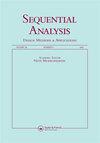Quickest change point detection with multiple postchange models
IF 0.6
4区 数学
Q4 STATISTICS & PROBABILITY
Sequential Analysis-Design Methods and Applications
Pub Date : 2020-10-01
DOI:10.1080/07474946.2020.1826795
引用次数: 2
Abstract
Abstract We study the sequential quickest change point detection for systems with multiple possible postchange models. A change point is the time instant at which the distribution of a random process changes. In many practical applications, the prechange model can be easily obtained, yet the postchange distribution is unknown due to the unexpected nature of the change. In this article, we consider the case that the postchange model is from a finite set of possible models. The objective is to minimize the average detection delay (ADD), subject to upper bounds on the probability of false alarm (PFA). Two different quickest change detection algorithms are proposed under Bayesian and non-Bayesian settings. Under the Bayesian setting, the prior probabilities of the change point and prior probabilities of possible postchange models are assumed to be known, yet this information is not available under the non-Bayesian setting. Theoretical analysis is performed to quantify the analytical performance of the proposed algorithms in terms of exact or asymptotic bounds on PFA and ADD. It is shown through theoretical analysis that when PFA is small, both algorithms are asymptotically optimal in terms of ADD minimization for a given PFA upper bound. Numerical results demonstrate that the proposed algorithms outperform existing algorithms in the literature.使用多个变更后模型进行最快速的变更点检测
摘要我们研究了具有多个可能的后变化模型的系统的顺序最快变化点检测。变化点是指随机过程的分布发生变化的时刻。在许多实际应用中,可以很容易地获得变化前的模型,但由于变化的意外性质,变化后的分布是未知的。在本文中,我们考虑后变化模型来自有限组可能的模型的情况。目标是根据虚警概率(PFA)的上限,最小化平均检测延迟(ADD)。在贝叶斯和非贝叶斯环境下,提出了两种不同的最快变化检测算法。在贝叶斯设置下,假设变化点的先验概率和可能的变化后模型的先验概率是已知的,但在非贝叶斯设置下该信息是不可用的。进行了理论分析,以根据PFA和ADD的精确或渐近边界来量化所提出算法的分析性能。理论分析表明,当PFA很小时,对于给定的PFA上界,两种算法在ADD最小化方面都是渐近最优的。数值结果表明,所提出的算法优于文献中现有的算法。
本文章由计算机程序翻译,如有差异,请以英文原文为准。
求助全文
约1分钟内获得全文
求助全文
来源期刊

Sequential Analysis-Design Methods and Applications
STATISTICS & PROBABILITY-
CiteScore
1.40
自引率
12.50%
发文量
20
期刊介绍:
The purpose of Sequential Analysis is to contribute to theoretical and applied aspects of sequential methodologies in all areas of statistical science. Published papers highlight the development of new and important sequential approaches.
Interdisciplinary articles that emphasize the methodology of practical value to applied researchers and statistical consultants are highly encouraged. Papers that cover contemporary areas of applications including animal abundance, bioequivalence, communication science, computer simulations, data mining, directional data, disease mapping, environmental sampling, genome, imaging, microarrays, networking, parallel processing, pest management, sonar detection, spatial statistics, tracking, and engineering are deemed especially important. Of particular value are expository review articles that critically synthesize broad-based statistical issues. Papers on case-studies are also considered. All papers are refereed.
 求助内容:
求助内容: 应助结果提醒方式:
应助结果提醒方式:


